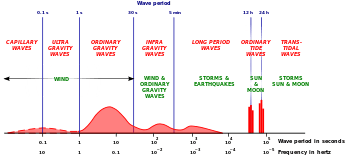Coastal engineering
Coastal engineering is the branch of civil engineering concerning the specific demands posed by constructing at or near the coast, as well as the development of the coast itself.
The hydrodynamic impact of especially waves, tides, storm surges and tsunamis and (often) the harsh environment of salt seawater are typical challenges for the coastal engineer – as are the morphodynamic changes of the coastal topography, caused both by the autonomous development of the system and man-made changes. The areas of interest in coastal engineering include the coasts of the oceans, seas, marginal seas, estuaries and big lakes.
Besides the design, building and maintenance of coastal structures, coastal engineers are often interdisciplinary involved in integrated coastal zone management, also because of their specific knowledge of the hydro- and morphodynamics of the coastal system. This may include providing input and technology for e.g. environmental impact assessment, port development, strategies for coastal defense, land reclamation, offshore wind farms and other energy-production facilities, etc.
Specific elements of coastal engineering

The coastal environment produces challenges specific for this branch of engineering: waves, storm surges, tides, tsunamis, sea level changes, sea water and the marine ecosystem.
Most often, in coastal engineering projects there is a need for metocean conditions: local wind and wave climate, as well as statistics for and information on other hydrodynamic quantities of interest. Also, bathymetry and morphological changes are of direct interest. In case of studies of sediment transport and morphological changes, relevant properties of the sea bed sediments, water and ecosystem properties are needed.
Long and short waves

The occurrence of wave phenomena – like sea waves, swell, tides and tsunamis – require engineering knowledge of their physics, as well as models: both numerical models and physical models. The practices in present-day coastal engineering are more-and-more based on models verified and validated by experimental data.
Apart from the wave transformations themselves, for the waves coming from deep water into the shallow coastal waters and surf zone, the effects of the waves are important. These effects include:
- the wave loading on coastal structures like breakwaters, groynes, jetties, sea walls and dikes
- wave-induced currents, like the longshore current in the surf zone, rip currents and Stokes drift, affecting sediment transport and morphodynamics
- wave agitation in harbors, which may result in harbor downtime
- wave overtopping over seawalls and dikes, which may e.g. threaten the stability of a dike
Notes
- ↑ Munk, W.H. (1950), Origin and generation of waves, Long Beach, California: ASCE, pp. 1–4
References
- Dean, R.G.; Dalrymple, R.A. (2004), Coastal Processes with Engineering Applications, Cambridge University Press, ISBN 9780521602754
- Hughes, S.A. (1993), Physical Models and Laboratory Techniques in Coastal Engineering, Advanced series on ocean engineering, World Scientific, ISBN 9789810215415
- Kamphuis, J.W. (2010), Introduction to Coastal Engineering and Management, Advanced series on ocean engineering, World Scientific, ISBN 9789812834843
- Kraus, N.C. (1996), History and Heritage of Coastal Engineering, American Society of Civil Engineers, ISBN 9780784474143
- Sorensen, R. (2013), Basic Coastal Engineering, Springer, ISBN 9781475726657
External links
- The Coastal Engineering Page, University of Delaware, retrieved 2015-05-26
- Coastal Engineering Proceedings, Texas Digital Library, retrieved 2015-06-05 – Archives of the proceedings of the International Conference on Coastal Engineering (ICCE), held since 1950 (biennially since 1960).